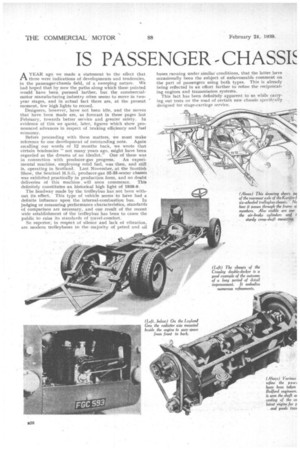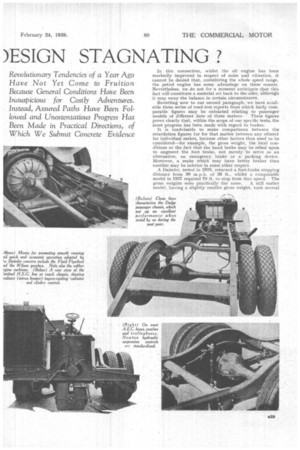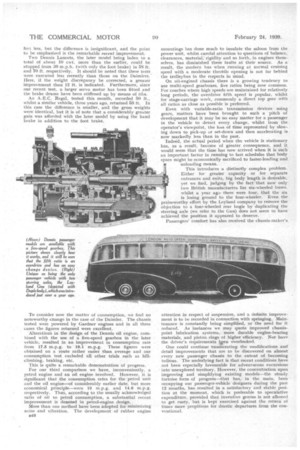IS PASSENGER -CHALSR )ESIGN STAGNATING?
Page 80

Page 81

Page 82

If you've noticed an error in this article please click here to report it so we can fix it.
Revolutionary Tendencies of a Year Ago Have Not Yet Come to Fruition Because General Conditions Have Been Inauspicious for Costly Adventures. Instead, Assured Paths Have Been Followed and Unostentatious Progress Has Been Made in Practical Directions, of Which We Submit Concrete Evidence AYEAR ago we made a statement to the effect that there were indications of developments and tendencies, in the passenger-chassis field, of a sweeping nature. We had hoped that by now the paths along which these pointed would have been pursued farther, but the commercialmotor manufacturing industry often seems to move in twoyear stages, and in actual fact there are, at the present moment, few high lights to record.
Designers, however, have not been idle, and the moves that have been made are, as forecast in these pages last February, towards better service and greater safety. In evidence of this we quote, later, figures which show pronounced advances in respect of braking efficiency and fuel economy.
Before proceeding with these matters, we must make reference to one development of outstanding note. Again recalling our words of 12 months back, we wrote that certain tendencies " not many. years ago, might have been regarded as the dreams of an idealist." One of these was in connection with producer-gas progress. An experimental machine, employing solid fuel, was then, and still is, operating in Scotland. Last November, at the Scottish Show, the Sentinel H.S.G. producer-gas 32-35-seater chassis was exhibited practically in production form, and no doubt
deliveries of this machine _ will soon commence. This definitely constitutes an historical high light of 1938-9. The headway made by the trolleybus has not been without its effect. This type of vehicle seems to have had a definite influence upon the internal-combustion bus. In judging or measuring performance characteristics, standards of comparison are necessary, and one result of the recent wide establishment of the trolleybus has been to cause the public to raise its standards of travel-comfort, So superior, in respect of silence and lack of vibration, are modern trolleybuses to the majority of petrol and oil buses running under similar conditions, that the latter have occasionally been the subject of unfavourable comment on the part of passengers using both types. This is already being reflected in an effort further to refine the reciprocating engines and transmission systems.
This fact has been definitely apparent to us while carrying out tests on the road of certain new chassis specifirally designed for stage-carriage service.
In this connection, whilst the oil engine has been markedly improved in respect of noise and vibration, it cannot be denied that, considering the whole speed range, the petrol engine has some advantage on these counts. Nevertheless, we do not for a moment anticipate that this fact will constitute a material set hack to the oiler, although it may sway the balance in Certain circumstances.
Reverting now to our second paragraph, we have available three series of road-test reports from which fairly comparable figures. may be extracted relating to passenger models of different date of three makers. .These figures prove clearly that, within the scope of our specific tests, the most progress has been made with regard to brakes.
It is inadvisable to make comparisons between the retardation figures (or for that matter between any others) for individual makes, because other factors then need to he considered—for example, the gross weight, the local conditions or the fact that the hand brake may be relied upon to augment the foot brake, not merely to serve as an alternative, an emergency brake or a parking device. Moreover, a make which may have better brakes than another may be inferior in some other respect. , A Daimler, tested in 1033, returned a foot-brake stopping distance from 30 m.p.h. of 30 ft., whilst a comparable model in 1037 required 78 ft. to stop from that speed. The gross weights were practically the same. A still earlier model, having a slightly smaller gross weight, took several
feet less, but the difference is insignificant, and the point to be emphasized is the remarkable recent improvement.
Two Dennis Lancets, the later model being laden to a total of about 10 cwt. more than the earlier, could be stopped from 30 m.p.h. (with only the foot brake) in 58 ft. and 70 ft. respectively. It should he noted that these tests were executed less recently than those on the Daimlers,' Here, if the weight discrepancy be corrected, a greater improvement than 12 ft. is indicated. Furthermore, since our recent test, alarger. servo motor has been fitted and the brake drums have been stiffened up by means of ribs.
An A.E.C. Regal, tested this month, recorded 50 ft, whilst a similar vehicle, three years ago, returned 38 ft. In this case the difference is smaller, and the gross weights were identical, but it is of note that a considerably greater gain was afforded With the later model by using the hand brake in addition to the foot brake.
To consider now the matter of consumption, we find no noteworthy change in the caseof the Daimler, The chassis tested were powered by Gardner engines and in all three cases the figures returned were excellent.
AlterationS in the design of the Dennis oil engine, combined with the use of a five-speed gearbox in the later vehicle, resulted in an improvement in consumption rate from 17.5 m.p.g. to 19.1 m.p.g. These figures were obtained on a route rather easier than average and our consumption test excluded all other trials such as hillclimbing, braking, etc.
This is quite a remarkable demonstration of progress.
For our third comparison we have, inconveniently, a petrol engine and an oil engine involved. However, it is significant that the consumption rates for the petrol unit and the oil engine—of considerably earlier date, but more economical principle—were 10 m.p.g. and 14.6 m.p.g. respectively. Thus, according to the 'usually acknowledged ratio of oil to petrol consumption, a substantial recent improvement is denoted in petrol-engine design.
More than one method have been adopted for minimizing noise and vibration. The development of rubber engine 040
mountings has done much to insulate the saloon from the power unit, whilst careful attention to questions of balance, clearances, material,' rigidity. and so forth, in engines themselves, has diminished these faults at their source. As a result, the modern bus when running at normal cruising speed with a moderate throttle opening is not far behind the trolleybus in the respects in mind.
On oil-engined chassis there is a growing tendency to use multi-speed gearboxes, five ratios being now common. For coaches where high speeds are maintained for relatively long periods, the overdrive fifth, speed is popular, whilst for stage-carriage work, commonly •a direct top gear with all ratios as close as possible is preferred.
Even with variable-ratio transmission devices using gears, matters have been brought to such a pitch of development that it may be no easy matter for a passenger in the vehicle to detect every change, whilst from the. operator's viewpoint, the loss of time represented by slowing down to pick-up or set-down and then accelerating is now markedly less than in the past.
Indeed, the actual Period when the vehicle is stationary has, as a result, become of greater consequence, and it would seem that the time has now arrived when it is such an important factor in running to fast schedules that body space might be economically sacrificed to faster-loading and unloading means. .
This introduces a distinctly complex problem. Either for greater capacity or for Separate entrances and exits, big body length is desirable, yet we find, judging by the fact 'that now only two British manufacturers list six-wheeled buses, whilst a year ago there were four, that the six is losing ground to the four-wheeler. Even the praiseworthy effort by the Leyland company to remove the objection to a four-wheeled rear bogie by duplicating the steering axle (we refer to the Gnu) does not seem to have achieved the position it appeared to deserve.
Passengers' comfort has also received the chassis-maker's
attention in respect of suspension, and a definite improvement is to be recorded in connection with springing. Maintenance is .constantly being simplified, or the need for it reduced. As instances we may quote improved chassispoint lubrication systems,. more durable engine-bearing materials, and piston rings of higher efficiency. Nor have the driver's requirements ifen overlooked. One could continue tuumerating the modifications and detail improvements that are to be discovered on almost every new passenger chassis to the extent of becoming tedious. The underlying fact is that recent conditions have not been especially favourable for adventurous excursions into unexplored territory. however, the concentration upon improving and simplifying existing models—the steady tortoise form of progress---that has, in the main, been occupying our passenger-vehicle designers during the past 12 months, has resulted in a satisfactory and stable position at the moment, which is preferable to speculative expenditure, provided that inventive genius is not allowed to get rusty, but is kept exercised against the return of times more propitious for drastic departures from the conventional.












































































































































